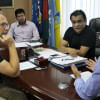Need to launch digital counter-narratives

In addition to the barbaric nature of the terrorist attacks in a Gulshan eatery and Sholakia Eid prayer, these assaults shocked us because of the social background of three of the assailants. These three came from the upper echelon of our society. The socio economic background of these three and several terrorists who have been captured or killed since has turned the conventional thinking about terrorism on its head.
The fact that young men from the privileged segment of our society could participate in such carnage was beyond any formerly held explanation. The background of the terrorists raises two obvious questions. How can these well-educated and well-bred young men be convinced to commit such heinous crimes? And how were they recruited and indoctrinated by extremists halfway around the world? Some of these young people may even be self-radicalized. In that case, what are the sources of their self-radicalization?
The educational and demographic backdrops of the young men may provide answers to these questions. At the same time, this information may also provide a potential pathway to deter the recruitment and indoctrination of potential militants.
Recently disclosed information by the Dhaka Metropolitan Police, RAB and other law enforcement organizations about the inner workings of Islamist terrorists underscore the role of the Internet in Jihadists' modus operandi. The recruitment, indoctrination and coordination of young people in these groups is leveraged through social media and internet based tools. In order to thwart the information flow used by the militants, the Bangladesh government has recently blocked thirty-five web based news portals.
However, the action of blocking certain web sites is actually a futile attempt by governments that aspire to interrupt terrorists' information sources. The content of these websites are quickly transported to new domain names and search engines keep providing the same old propaganda with ease to those who seek such information. It should be noted that governments around the world resort to blocking of websites that contain incendiary material despite the fact that blocking effectively blocks a URL (a Universal Resource Locator or the web address) only and fails to block the content that is swiftly transported to a new website. The latest technologies on the Internet that facilitate dynamic Web content generation only enhances the quick transfer process.
What then is the course of action for Bangladesh to fight the terrorists in the cyberspace? A recent article in the Wall Street Journal ("Tech Giants Target Terrorist Propaganda," July 31) cites a research based approach to disrupt the recruiting and indoctrination of young men and women. The research was conducted by the Institute for Strategic Dialogue (ISD), a London based think tank that studies the role of ideology in promoting violent extremism. Three technology giants Google, Facebook and Twitter collaborated with ISD to test the effectiveness of a "counter narrative" campaign. Based on encouraging preliminary results of this study, it would be worthwhile for organizations to emulate the campaign in Bangladesh.
In the study, almost half a million young adults and teenagers whose posted content in Facebook included certain key words such as "sharia" or "mujahideen" received a series of video pop ups showing animated contents with counter narrative messages to Jihadists' agenda. The objective of the study was to gauge the effectiveness of the messages and targeting of potential extremists before they are radicalized. The essence of the intervention is based on the thesis that "…..it is a battle of ideas", stated Zahed Amanullah, who heads the counter narrative initiatives at ISD and a co-author of the study.
Two counter narrative campaigns were used to target young people who could be potentially radicalized by the propaganda of Islamic State or such groups (a third looked at right-wing extremists in the US). The first US-based campaign included a video titled "The Bullet or the Ballot" and was shared on Facebook, Twitter and YouTube. It reached almost half a million Facebook users leading to more than ten thousand interactions in terms of "likes," "shares" and comments.
Harakat-ut-Taleem was the second campaign aimed at dissuading potential recruits of the Taliban in Pakistan. For security reasons, an anonymous group ran the campaign in Pakistan. This second campaign used Urdu as the language of the video. The Facebook reach of the video was more than two hundred thousand views leading to over four thousand interactions.
The Pakistani campaign is of particular relevance to Bangladesh. The proliferation of social media among Bangladeshi middle and upper middle class youth is self-evident. This is the part of the cyberspace where militant propaganda is the easy to find. The educated youth targeted for recruiting by the terrorist groups are frequent visitors to social media. Campaigns adopted in Bangla can be effective counter narrative in this space.
A noticeable characteristic of these counter narratives is the non-governmental creation and implementation of the campaigns. The researchers avoided any association with the government in order to not taint the messages with any state support. The non-government nature of the counter narrative campaigns enhance the legitimacy of the intervention to the target audience, that is, the young people seeking spiritual and political directions.
Amanullah offered me several insights from campaigns that have been conducted by his organization in several countries. First and foremost, the content of the counter narrative must be built using real and compelling messages. In the Harakat-ut-Taleem campaign in Pakistan, former extremists provided the content and participated in the message. This may be hard to do in Bangladesh at present. However, the messages must address the issues that motivate potential radicalization.
This takes us to the second insight. The motivations for radicalization can be categorized into push and pull factors. Push factors include corruption in our society and a lack of opportunity to make a difference in the society while the pull factors include state building which happens to be the biggest draw for the Islamic State. Counter narratives must address these motivations.
The third insight was about the Internet based software used in the campaigns to target potential would be extremists. These targeting tools were digital applications already in existence and used by technology giants such as Google and Facebook for marketing purposes. Therefore, no new software would be necessary to launch such counter narrative campaigns in Bangladesh. However, "there is need for capacity building before successful campaigns can be launched," Amanullah suggested to me in a video conference. "People have to be trained to create and deliver the counter narratives."
After the recent carnages in Gulshan and Sholakia, we need to engage in such capacity building to provide an alternative explanation of the world to potential extremists among us.
The writer is a Fulbright Fellow and Professor in California State University

 For all latest news, follow The Daily Star's Google News channel.
For all latest news, follow The Daily Star's Google News channel. 








Comments